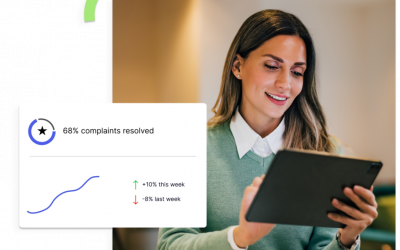Successful business leaders base decisions on data and monitor key performance indicators (KPIs) to keep their companies on the right track. Using a software tool that aggregates multiple internal and external data sources can help create easy-to-use dashboards for the decision makers at every level of your organization. These insight dashboards will help stakeholders easily access both analytical data and narrative data so they can do their jobs more effectively and make timely decisions with confidence.
While a dashboard for an executive might look very different from an insight dashboard customized for a personnel manager, both dashboards can be created to anticipate their needs and viewpoints. A flexible, configurable system is key to providing each user with the specific dashboards they need for both strategic and day-to-day business decisions.
Current Workforce Insight Dashboards
A dashboard that has a holistic view of your company’s workforce might be just what a CEO or head of human resources needs when it’s time to hire, or for compliance reporting. These metrics and insights can also help leadership evaluate the current state of the organization and identify any gaps they should address.
During a routine review of this dashboard, it might become apparent that turnover is higher in one branch than another, leading to questions about management practices or day-to-day operations. Going into 2023, one of CEOs’ top concerns is workforce retention across their organizations, so this information will be highly relevant to leadership as they review workforce status this year.
Workforce dashboards can also include the following features:
- Demographics of each team or company-wide
- Mobility or movement for a picture of how employees advance and those that might have the potential to take on new roles
- Compensation data, which is valuable for budgeting, making offers to new employees, and ensuring equity
Diversity, Equity, Inclusion & Belonging
Many organizations are focused on diversity, equity, inclusion, and belonging (DEIB) goals. However, while some metrics are easy to track, others, like the feeling of belonging, can be hard to capture in analytics. Insight dashboards that combine narrative data from surveys with data from other sources can reveal employee sentiment and inconsistencies in your policies and practices.
You should customize dashboards based on users’ needs. For example, a Chief Diversity Officer might have a dashboard that examines company-wide statistics while an HR team lead might have access to hiring processes and data which could reveal unconscious biases.
An insight dashboards adapted to the specific needs of a DEIB officer might include:
- Demographics with instant insights into specific teams or company-wide trends
- Diversity metrics
- Compensation by demographic
- Promotions and pending promotions
- Tenure and employee retention
- Individual employee performance, including identifying high-performers and those with potential for advancement
- New hire pipeline
- Candidate pools
- Screened applicants
- Hiring sources
- Apply to offer journey
- New hire tracking
Benefits & Payroll
Part of an effective employee retention strategy is monitoring benefits and payroll, especially in a recovering economy and competitive employment market. People managers and HR teams understand the need to not only monitor benefits and payroll, but to keep people apprised of their current benefits. This could be a simple query for how much remaining paid time off a single employee has to insights about the sick leave for entire teams at a glance.
This dashboard should give you quick access to data and insights including:
- Base pay
- Compa-ratios
- Merits, commissions, and bonuses
- Hours worked
- Leave balances
Employee Engagement Data
Monitoring and managing employee engagement is essential for ensuring job satisfaction. According to a recent Gallup study, businesses with actively engaged employees are 23% more profitable. Understanding how individual employees are performing and how different business groups are interacting is key to your organization’s overall health and success.
Data points and insights that can give you a quick pulse into the health of employee engagement include:
- Recognition, awards
- Continuing education: enrollments, completions, hours, and learning investment
- Time and attendance, including no shows and cancellations
- Survey results and insights
- Volunteer hours
- Mentoring program hours
- Social engagement
Performance Management & Monitoring
Having regular and transparent performance reviews can help boost employee morale, enhance employee retention rates, and contribute to employee advancement. Alarmingly, in a recent study 44% of HR leadership doesn’t think their organization has viable career paths for their employees. One way to get ahead of this pitfall is to actively monitor goals, skills gaps, and potentials.
Keep a pulse on performance between review periods with data and information like:
- Evaluation cycles
- Average performance ratings
- High performers and potentials
- Low performers
- Leadership qualities
- Goals/goal progress tracking
- Skill gap analysis notes
- Compliance notes
Succession Planning Dashboards
An employee voluntarily leaving your business is never easy, but it can be disastrous if the individual works at a high level and there’s no plan in place to capture and archive that individual’s company knowledge before they leave. Be prepared for attrition with formal succession planning.
Dashboards that can help ease these transitions will include:
- Organizational structure charts
- Job or position readiness
- Competency assessments
- Job descriptions
- Bench strengths
- Development plans and progress tracking
- SWOT analysis
- Risk of loss
- Career path ratio
Talent Acquisition
Keeping your team staffed with qualified, enthusiastic individuals helps drive revenue and prevent burnout among high performers. People managers, especially, benefit from dashboards that help them streamline hiring processes. These dashboards can be collaborative so that HR, DEIB, managers, and executives can all easily see where your business is in the hiring process. These dashboards can also be used to track any unintentional bias in your screening process and hiring offers.
As you need new talent, there are usually several stakeholders throughout your business who will need to track and collaborate on:
- Open positions
- Candidate pools
- Applicants screened
- Hiring sources
- Apply to offer
- Time to fill
- Percent of offers accepted
- Cost per hire
Building Your Perfect Insight Dashboards
The first step in creating exceptional dashboards is to determine the data that each of your team members needs to do their jobs successfully. Next, evaluate the software your business currently uses to see if it can create a robust, intuitive insight dashboard. Additionally, you want to evaluate whether or not it is capable of managing automatic integrations and handling large volumes of data from multiple sources.
You may also find that it’s beneficial to build dashboards using archival data in addition to recent information to get a better understanding of the big picture for your organization.
Remember that one dashboard will not serve everyone in your organization effectively. When you build dashboards based on anticipated queries, needs, and growth predictions you spend your time building a tool that will grow with the user and the business. Custom dashboards give users the ability to have the most effective visualization tools tailored to their needs that provide insight from the most updated data available.
If you’ve determined that insight dashboards would be valuable to your organization, but you don’t have the bandwidth or technology expertise to create them, work with an industry expert. ZeroedIn works with clients across a range of markets and niches to create tools they can use now and well into the future. Let us show you what we can build together.




